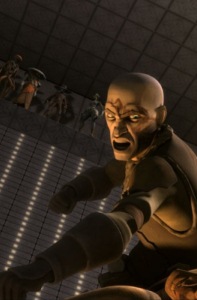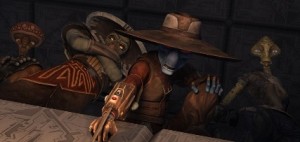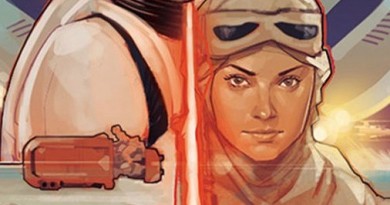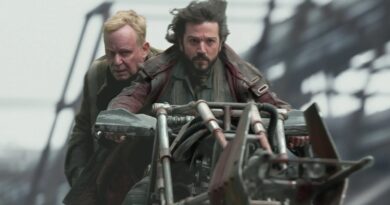The Clone Wars – Thinking Outside The Box
 Last week’s episode of The Clone Wars has yielded some interesting discussions. Check out Megan’s review to see her reaction to “The Box.” We’re both enjoying the arc. I hope to go into some more detail on the storytelling and philosophical ideas in the arc when it’s complete, but for now here are a few things to think about:
Last week’s episode of The Clone Wars has yielded some interesting discussions. Check out Megan’s review to see her reaction to “The Box.” We’re both enjoying the arc. I hope to go into some more detail on the storytelling and philosophical ideas in the arc when it’s complete, but for now here are a few things to think about:
- A number of people criticized “The Box” for getting away from the plot to kidnap the Chancellor. From the start, though, it seemed pretty clear to me that the kidnap plot is the MacGuffin – the plot device to set the story in motion and move it forward, but not actually the story. It’s quite typical to introduce a MacGuffin in the opening act of a story and never use it again, like the Sith tassels in the Legacy of the Force series, or resurrect it later in the climax, like the Ark of the Covenant in Raiders of the Lost Ark. What’s important in this arc is primarily Obi-Wan’s development as a character (and on a broader level how he represents the moral struggle within the Jedi Order), and how it affects his (and the Order’s) relationship with Anakin.
- Moralo Eval’s role seems to have perplexed more than a few viewers, too. His name and his actions, though, tell his part in the story. Like many other Star Wars names, from Greedo to Savage Opress, the name Moralo Eval give a clear sense of what the character represents.
 For the in media res style of Star Wars, it saves a lot of effort in character-building. Derived from the philosophical term moral evil, his name denotes evil acts resulting from the direct, intentional actions of an agent (as distinct from natural evil, which occurs without an agent causing it). In fact, Moralo Eval is the agent for a series of evil acts. From the first episode of the arc, he acts in a way that is different from the bounty hunters like Cad Bane, and by the time the third episode ends it’s clear he has no “code” or conscience, and that is why he can’t lead the mission. There are a lot of philosophical ideas presented in this story, but it will be hard to understand the final impact until the arc is complete. But I suspect the philosophical underpinnings behind the notion of moral evil shed some light on the goal of the story and where it’s headed.
For the in media res style of Star Wars, it saves a lot of effort in character-building. Derived from the philosophical term moral evil, his name denotes evil acts resulting from the direct, intentional actions of an agent (as distinct from natural evil, which occurs without an agent causing it). In fact, Moralo Eval is the agent for a series of evil acts. From the first episode of the arc, he acts in a way that is different from the bounty hunters like Cad Bane, and by the time the third episode ends it’s clear he has no “code” or conscience, and that is why he can’t lead the mission. There are a lot of philosophical ideas presented in this story, but it will be hard to understand the final impact until the arc is complete. But I suspect the philosophical underpinnings behind the notion of moral evil shed some light on the goal of the story and where it’s headed. - While many have noted the significance of the Anakin/Yoda scene in “The Box,” I haven’t seen much discussion about the overall parallels coming from this arc, and even this season, to The Empire Strikes Back and what that might imply for the series. Anakin is told by Yoda to trust his friends, much like the elder Jedi Master’s admonitions to Luke in the Original Trilogy. The bounty hunters are gathered just like they were in Episode V, and the arrival of Eval, Bane, and Hardeen on Serreno is a direct visual homage to the Falcon’s passengers nervously greeting Lando at Cloud City. Looking back at Seasons Three and Four, and knowing that this season will end with a cliffhanger, I think it’s quite possible that we’re seeing some very strong parallels deliberately being drawn to the middle movie of the Original Trilogy. While I know Dave Filoni, Christian Taylor, and others talk about how many more stories they have to tell, they’re also smart enough not to let people get too sidetracked with talk of THE END. To me, it’s looking more and more possible that Season Six, which would end the same spring we would be due for the release of Revenge of the Sith in 3D at one film per year, would be a natural place to end a series set between Episodes II and III.
 In fact, I’d venture to guess they’ll end the series as they started it – in the movie theater. I’ll be watching and looking to see if the conclusion of this arc, and the Darth Maul arc, give any more support to my theory…
In fact, I’d venture to guess they’ll end the series as they started it – in the movie theater. I’ll be watching and looking to see if the conclusion of this arc, and the Darth Maul arc, give any more support to my theory… - Finally, looking ahead to this Friday’s episode, “Crisis on Naboo,” how about that preview image of the refinery? The economics of plasma mining and refining on Naboo played a major role in the political subplots of Darth Plagueis, and it would be great to see a nod to that in TCW. I’m a big fan of these kinds of synergy between TCW and the EU.
- Hyperspace Theories: Bad Luck Ghorman - June 2, 2025
- Hyperspace Theories: One Year Later as ANDOR Kicks Off Season Two - May 15, 2025
- REVIEW: Tales of the Underworld - May 4, 2025










